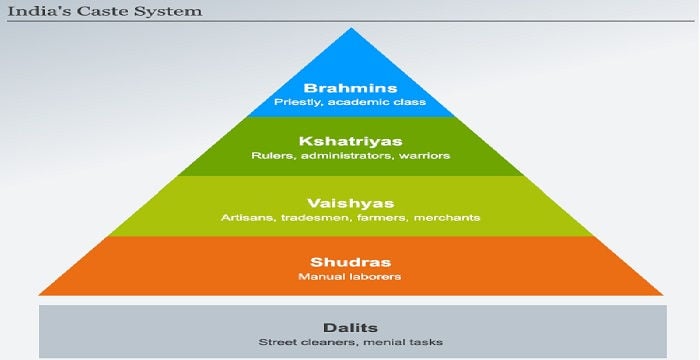
In
the transition from Vedic religion to Hinduism proper, one important feature is
the development of the stratified social system that in India became known as
the caste system.
Texts dating from the late centuries before the Common Era, such as the Laws of Manu, began to make clear that the four classes found in the Vedas were now seen as stratified social entities. Rules and social laws began to be passed down, not universally, but in terms of each class or “birth” (jati) division. Brahmins, here, were placed at the apex of the pyramid, because of their priestly positions. (However, they were also not allowed to accumulate large amounts of wealth and could not hold positions of direct political power.) Next were the warriors, or Kshatriyas, who held kingly and administrative power. The large body of the people, the Vish, or Vaishya, were farmers or merchants. The lowest class were the Shudras, born, it was thought, to be servants.
Texts dating from the late centuries before the Common Era, such as the Laws of Manu, began to make clear that the four classes found in the Vedas were now seen as stratified social entities. Rules and social laws began to be passed down, not universally, but in terms of each class or “birth” (jati) division. Brahmins, here, were placed at the apex of the pyramid, because of their priestly positions. (However, they were also not allowed to accumulate large amounts of wealth and could not hold positions of direct political power.) Next were the warriors, or Kshatriyas, who held kingly and administrative power. The large body of the people, the Vish, or Vaishya, were farmers or merchants. The lowest class were the Shudras, born, it was thought, to be servants.
As
time went on and the tradition expanded its reach into all parts of India,
indigenous tribes and other groups entering the society of Aryans were absorbed
at an even lower rung of the social ladder. Eventually the concept of the
untouchable (contemporary Dalit) was created to refer to people whom the upper
castes would not even allow to be near or to touch them. Hinduism developed
into a society where people became ranked rigidly by occupation. The sacerdotal
position, or priestly work, was considered purest. Work that involved dealing
with the dead, carrion, cleaning of sewers, sweeping, and other such tasks, was
considered “unclean” and was performed only by hereditary untouchables.
Comments
Post a Comment